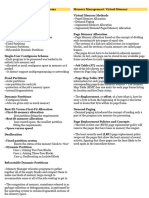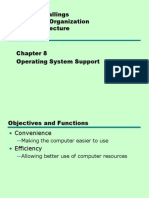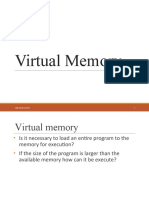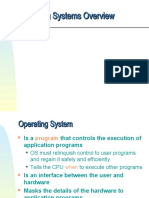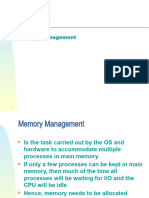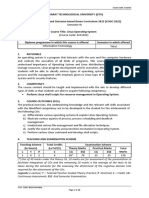It 480:informationtechnology Essentials: Vineetha Jain Dept. of Cse Ase, Bangalore
Uploaded by
Premchand ChidipothuIt 480:informationtechnology Essentials: Vineetha Jain Dept. of Cse Ase, Bangalore
Uploaded by
Premchand ChidipothuIT 480:InformationTechnology
Essentials
Vineetha Jain
Dept. of CSE
ASE, Bangalore
Lecture 05&06&07
Operating System
ASE, Bangalore2
Jan 28, 2010 Vineetha Jain
Introduction
Operating System is an interface between computer
and user
Its program manages computer hardware.
Its an environment helps to execute programs
It acts as a government.
It acts as an resource manager.
It manages the resources like Memory,Processor,I/O
and Information.
Block diagram
ASE, Bangalore3
Jan 28, 2010 Vineetha Jain
Introduction
Memory management
Process management
Device management
File management
ASE, Bangalore4
Jan 28, 2010 Vineetha Jain
Views
It has system view
Also users view
ASE, Bangalore5
Jan 28, 2010 Vineetha Jain
Address
Logical address:Address generated by CPU
Physical address:Address loaded to
memory(loaded to MAR) ie, by memory unit.
ASE, Bangalore6
Jan 28, 2010 Vineetha Jain
Memory allocation Techniques
Single Contiguous Memory allocation:
Users job is the only program which resides in
the memory.
Simple to implement.
Disadv:
Wastage of memory called fragmentation
Used only for uniprogramming
CPU has to sit idle.
ASE, Bangalore7
Jan 28, 2010 Vineetha Jain
Memory allocation
Fixed partition memory allocation:
Fixed size partitions
Provides multiprogramming
External fragmentation :Contiguous space is
not allowed
Internal fragmentation :Wastage of memory or
unused space
ASE, Bangalore8
Jan 28, 2010 Vineetha Jain
Variable partition allocation:
Allocate exact amount required for each job
Supports multiprogramming
Prevents internal fragmentation
But still cause external fragmentation
Hole: Leave the job and empty the space
Merge the hole is known as Coalescene
ASE, Bangalore9
Jan 28, 2010 Vineetha Jain
Relocatable Partition memory allocation:
Reloacte the currently executing program
Merging the holes
Compaction:get a large block of free memory
Supports multiprogramming
Prevents internal and external fragmentation
ASE, Bangalore10
Jan 28, 2010 Vineetha Jain
Simple paged allocation:
Overcome external fragmentation
Address space
Logical address space
Physical address space
Divide job address space in to pages
Main memory address space in to frames or
blocks.
Mapping
ASE, Bangalore11
Jan 28, 2010 Vineetha Jain
Simple paged allocation
Page table and address translation
Internal fragmentation due to simple page
allocation.
Supports multiprogramming
Jobs need not occupy contiguous allocation
Prevents external fragmentation
Virtual memory concept
ASE, Bangalore12
Jan 28, 2010 Vineetha Jain
Demand paging
Pages are loaded based on demand
Based on the requirement
Works based on virtual memory concept
Jobs need not occupy contiguous memory
location
Supports multiprogramming
Prevents external fragmentation
Status field: whether is in memory or secondary.
Modified: modification done or not
ASE, Bangalore13
Jan 28, 2010 Vineetha Jain
Demand paging
Demand paging leads to page fault.
Page fault: try access the page which is not there
in main memory.
Swapping
Page Replacement algorithm
FIFO
LRU
MFU
LFU
NRU
ASE, Bangalore14
Jan 28, 2010 Vineetha Jain
Segmentation
Divide jobs address space in to segments
Size of segments can vary.
Segment table and translation.
Does not support virtual memory concept.
Supports multiprogramming
Jobs need not occupy contiguous memory
location.
Prevents internal fragmentation
ASE, Bangalore15
Jan 28, 2010 Vineetha Jain
Process management
Program
Process
Structure of process
Process consists of 3 regions
Stack region :It is a data structure, where data
removed in the reverse order.
Code region: It has program code
Data region :holds the global variables
ASE, Bangalore16
Jan 28, 2010 Vineetha Jain
Multiple process
Independent process:
Cooperating process
ASE, Bangalore17
Jan 28, 2010 Vineetha Jain
Process State
New state:
Ready:
Running:
Waiting:
Terminated
ASE, Bangalore18
Jan 28, 2010 Vineetha Jain
Process state diagram
Terminate
New
READY RUNNING
WAITING
ASE, Bangalore19
Jan 30 2010 Vineetha Jain
Inter process communication
Communication between cooperating
processes is IPC:
Communication models
Shared memory
Message passing
ASE, Bangalore20
Jan 30, 2010 Vineetha Jain
Multiprogramming :Uniprocessor executes
more than one program
Multiprocessing :Multiprocessor system
Multitasking :Context switching
ASE, Bangalore21
Jan 28, 2010 Vineetha Jain
Threads
Single threads
Multithreads
Thread structure
example
ASE, Bangalore22
Jan 28, 2010 Vineetha Jain
Process scheduling
CPU Utilization
Throughput
Turnaround time
Waiting time
Response Time
ASE, Bangalore23
Jan 21, 2010 Vineetha Jain
Types of scheduling
Preemptive
Nonpreemtive
ASE, Bangalore24
Jan 21, 2010 Vineetha Jain
Scheduling algorithms
FCFS
SJF
Preemptive
Non-preemptive
Priority
Round Robin(RR)
Examples
ASE, Bangalore25
Jan 21, 2010 Vineetha Jain
File management
Storage unit
File system:information management and part of OS.
MS DOS file system:
Tree structure
Path
Hard disk in MS DOS
Hard disk structure
Data access –File allocation table gives the
information about where the file is allocated in the
disk
ASE, Bangalore26
Jan 21, 2010 Vineetha Jain
File management
Volume :Storage size
Hard disk can have volumes
MS DOS Booting
Bootstrap loader :Program
ASE, Bangalore27
Jan 21, 2010 Vineetha Jain
File system mangement
UNIX file system
UNIX OS hard disk can be divided in to
multiple file systems.
Unix allocates disk space in terms of blocks
File organization
Directory Entry Table
Inode block
Data Block
Data access
ASE, Bangalore28
Jan 21, 2010 Vineetha Jain
File permissions
Owner ,Group ,Others
Read( R)
Write(W)
Execute(X)
ASE, Bangalore29
Jan 21, 2010 Vineetha Jain
NTFS
New technology file system
Windows NT
Features: Reliability,performance,security and
optimal disk space utilization.
Security and access control:
Size of the files/no.of files
Recovery/Reliabilty:
Long file names
Limitations:file encryption is not built, formatting
floppy disk
ASE, Bangalore30
Jan 21, 2010 Vineetha Jain
Device management
I/O devices
I/O channel or I/O bus
Interrupts
Interrupt handling
Software interrupts
Hardware interrupts
ASE, Bangalore31
Jan 21, 2010 Vineetha Jain
DMA
Direct Memory Access
DMA controller
CPU initiates, but access between memory
and I/O devices
ASE, Bangalore32
Jan 21, 2010 Vineetha Jain
Structure of I/O System
Device allocation
Dedicated and shared
ASE, Bangalore33
Jan 21, 2010 Vineetha Jain
Summary
Introduction to OS
Memory management
Process management
Process states
Process scheduling algorithms
Storage management
Device management
DMA
ASE, Bangalore34
Jan 21, 2010 Vineetha Jain
Reference:
Operating System concepts
Galvin and Silber Schatz(6th edition)
ASE, Bangalore35
Jan 30, 2010 Vineetha Jain
Thank U
ASE, Bangalore36
Jan 30, 2010 Vineetha Jain
You might also like
- CSE 380 Computer Operating Systems: Instructor: Insup LeeNo ratings yetCSE 380 Computer Operating Systems: Instructor: Insup Lee22 pages
- Downlink Frequency-Selective Scheduling: Feature DescriptionNo ratings yetDownlink Frequency-Selective Scheduling: Feature Description19 pages
- CST206 Operating Systems Important TopicsNo ratings yetCST206 Operating Systems Important Topics10 pages
- CSC204 - Chapter 3.2 OS Performance Issue (Memory Management) - NewNo ratings yetCSC204 - Chapter 3.2 OS Performance Issue (Memory Management) - New40 pages
- Operating System Support: William Stallings Computer Organization and Architecture 7 EditionNo ratings yetOperating System Support: William Stallings Computer Organization and Architecture 7 Edition51 pages
- He-Dieu-Hanh - Kai-Li - Vmdesign - (Cuuduongthancong - Com)No ratings yetHe-Dieu-Hanh - Kai-Li - Vmdesign - (Cuuduongthancong - Com)24 pages
- DCA6201 Operating System (All Units) PDFNo ratings yetDCA6201 Operating System (All Units) PDF258 pages
- Operating System: Operating Systems: Internals and Design PrinciplesNo ratings yetOperating System: Operating Systems: Internals and Design Principles51 pages
- CSC 539: Operating Systems Structure and Design Spring 2005: Memory ManagementNo ratings yetCSC 539: Operating Systems Structure and Design Spring 2005: Memory Management26 pages
- Top 50 Operating System Interview Questions: 1) Explain The Main Purpose of An Operating System?No ratings yetTop 50 Operating System Interview Questions: 1) Explain The Main Purpose of An Operating System?11 pages
- Memory Management: Background Swapping Contiguous Allocation Paging Segmentation Segmentation With PagingNo ratings yetMemory Management: Background Swapping Contiguous Allocation Paging Segmentation Segmentation With Paging55 pages
- CS3451 OPERATING SYSTEM 01 - by WWW - Learnengineering.inNo ratings yetCS3451 OPERATING SYSTEM 01 - by WWW - Learnengineering.in96 pages
- Basic Principles of an Operating System: Learn the Internals and Design PrinciplesFrom EverandBasic Principles of an Operating System: Learn the Internals and Design PrinciplesNo ratings yet
- Embedded and Real Time Systems Question BankNo ratings yetEmbedded and Real Time Systems Question Bank45 pages
- Vijay Kumar: IBPS (SO) I.T.O Cer: Operating System Study NotesNo ratings yetVijay Kumar: IBPS (SO) I.T.O Cer: Operating System Study Notes20 pages
- 1.towards Optimizing Task Scheduling Process in Cloud EnvironmentNo ratings yet1.towards Optimizing Task Scheduling Process in Cloud Environment7 pages
- Mac OS X S IO Management and Disk SchedulingNo ratings yetMac OS X S IO Management and Disk Scheduling14 pages
- Wonderware ® FactorySuite™ (InBatch Getting Started)No ratings yetWonderware ® FactorySuite™ (InBatch Getting Started)82 pages
- Class 11 - Maintenance Planning and Scheduling - DR - Adel100% (3)Class 11 - Maintenance Planning and Scheduling - DR - Adel30 pages
- Real Time Operating System: Prof. Anish Goel, Assistant Professor, RCOEMNo ratings yetReal Time Operating System: Prof. Anish Goel, Assistant Professor, RCOEM35 pages
- Open Source Software Semester 6 Text BooksNo ratings yetOpen Source Software Semester 6 Text Books182 pages
- Algorithm For Scheduling Runway Operations Under Constrained Position ShiftingNo ratings yetAlgorithm For Scheduling Runway Operations Under Constrained Position Shifting4 pages
- Loading, Sequencing, Routing, SchedulingNo ratings yetLoading, Sequencing, Routing, Scheduling7 pages
- Writing A Message Broker in Golang: George Vanburgh Supervised by Alvaro A.A. Fernandes May 3, 2016No ratings yetWriting A Message Broker in Golang: George Vanburgh Supervised by Alvaro A.A. Fernandes May 3, 201667 pages












